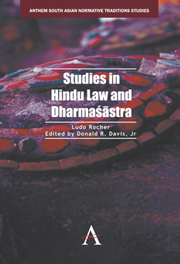Book contents
- Frontmatter
- Contents
- Foreword by Richard W. Lariviere
- Preface
- Abbreviations
- Note on the Edition
- Introduction
- PART ONE THE NATURE OF HINDU LAW
- Hindu Conceptions of Law
- The Historical Foundations of Ancient Indian Law
- Hindu Law and Religion: Where to Draw the Line
- Law Books in an Oral Culture: The Indian Dharmaśūstras
- Schools of Hindu Law
- Changing Patterns of Diversification in Hindu Law
- PART TWO GENERAL TOPICS OF HINDU LAW
- PART THREE HINDU LEGAL PROCEDURE
- PART FOUR TECHNICAL STUDIES OF HINDU LAW
- PART FIVE ANGLO-HINDU AND CUSTOMARY LAW
- Bibliography
- Index
Changing Patterns of Diversification in Hindu Law
from PART ONE - THE NATURE OF HINDU LAW
Published online by Cambridge University Press: 05 February 2013
- Frontmatter
- Contents
- Foreword by Richard W. Lariviere
- Preface
- Abbreviations
- Note on the Edition
- Introduction
- PART ONE THE NATURE OF HINDU LAW
- Hindu Conceptions of Law
- The Historical Foundations of Ancient Indian Law
- Hindu Law and Religion: Where to Draw the Line
- Law Books in an Oral Culture: The Indian Dharmaśūstras
- Schools of Hindu Law
- Changing Patterns of Diversification in Hindu Law
- PART TWO GENERAL TOPICS OF HINDU LAW
- PART THREE HINDU LEGAL PROCEDURE
- PART FOUR TECHNICAL STUDIES OF HINDU LAW
- PART FIVE ANGLO-HINDU AND CUSTOMARY LAW
- Bibliography
- Index
Summary
What I intend to do today is to take you through the history of Hindu law, from the earliest times until today, and show you various patterns of diversification as they manifested themselves at different times in history. I would like to show you an area of knowledge, and, at the same time, an area of human behavior: the laws of the Hindus, how the patterns of diversification across the Subcontinent changed in the course of time. There were always good reasons for these changes, and even the most orthodox Hindus have come forward to justify them.
You are, of course, familiar with an institution that, with a term derived from Latin, we call levirate. When I consulted the Encyclopaedia Britannica on the subject, I found: “In ancient Hebrew society, when a man died without sons his brother was required to marry the widow in order to provide a ‘son’ and heir to the dead man, thus perpetuating the paternal line.” I also learned that “a sample of 185 primitive societies of the 19th and 20th centuries found that 69% exhibited a preference for some such form of secondary marriage.” Finally, the author of the article stated that “a similar custom prevailed among the Vedic Aryans of India (1500 to 1000 BC), among whom the son performed funeral rites for the salvation of his deceased father's soul.”
Now let me quote from one of our classical Sanskrit lawbooks:
On failure of issue (by her husband) a woman who has been authorised, may obtain, (in the) proper (manner prescribed), the desired offspring by (cohabitation with) a brother-in-law or (with some other) sapiṇḍa (of the husband).
- Type
- Chapter
- Information
- Studies in Hindu Law and Dharmasastra , pp. 129 - 142Publisher: Anthem PressPrint publication year: 2012



